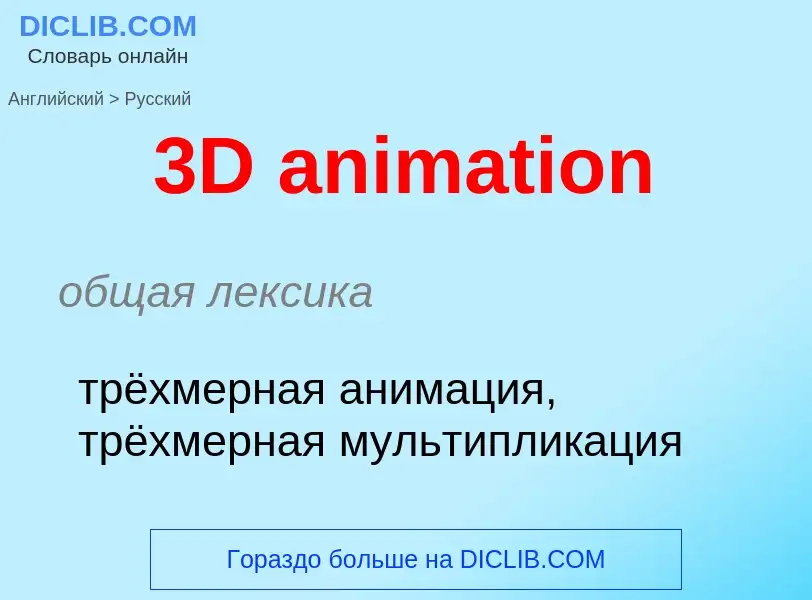Traducción y análisis de palabras por inteligencia artificial ChatGPT
En esta página puede obtener un análisis detallado de una palabra o frase, producido utilizando la mejor tecnología de inteligencia artificial hasta la fecha:
- cómo se usa la palabra
- frecuencia de uso
- se utiliza con más frecuencia en el habla oral o escrita
- opciones de traducción
- ejemplos de uso (varias frases con traducción)
- etimología
3D animation - traducción al Inglés
кинематография
мультипликация
мультипликационный фильм
Wikipedia
Computer animation is the process used for digitally generating animations. The more general term computer-generated imagery (CGI) encompasses both static scenes (still images) and dynamic images (moving images), while computer animation only refers to moving images. Modern computer animation usually uses 3D computer graphics to generate a three-dimensional picture. The target of the animation is sometimes the computer itself, while other times it is film.
Computer animation is essentially a digital successor to stop motion techniques, but using 3D models, and traditional animation techniques using frame-by-frame animation of 2D illustrations. Computer-generated animations can also allow a single graphic artist to produce such content without the use of actors, expensive set pieces, or props. To create the illusion of movement, an image is displayed on the computer monitor and repeatedly replaced by a new image that is similar to it but advanced slightly in time (usually at a rate of 24, 25, or 30 frames/second). This technique is identical to how the illusion of movement is achieved with television and motion pictures.
For 3D animations, objects (models) are built on the computer monitor (modeled) and 3D figures are rigged with a virtual skeleton. Then the limbs, eyes, mouth, clothes, etc. of the figure are moved by the animator on key frames. The differences in appearance between key frames are automatically calculated by the computer in a process known as tweening or morphing. Finally, the animation is rendered.
For 3D animations, all frames must be rendered after the modeling is complete. For pre-recorded presentations, the rendered frames are transferred to a different format or medium, like digital video. The frames may also be rendered in real-time as they are presented to the end-user audience. Low bandwidth animations transmitted via the internet (e.g. Adobe Flash, X3D) often use the software on the end user's computer to render in real-time as an alternative to streaming or pre-loaded high bandwidth animations.

![3D game character animated using [[skeletal animation]]. 3D game character animated using [[skeletal animation]].](https://commons.wikimedia.org/wiki/Special:FilePath/3D dragon animation.gif?width=200)

![An example of traditional animation, a horse animated by [[rotoscoping]] from [[Eadweard Muybridge]]'s 19th-century photos. An example of traditional animation, a horse animated by [[rotoscoping]] from [[Eadweard Muybridge]]'s 19th-century photos.](https://commons.wikimedia.org/wiki/Special:FilePath/Animhorse.gif?width=200)

![Finnish]] television commercial Finnish]] television commercial](https://commons.wikimedia.org/wiki/Special:FilePath/Claychick.jpg?width=200)
![A projecting [[praxinoscope]], from 1882, here shown superimposing an animated figure on a separately projected background scene A projecting [[praxinoscope]], from 1882, here shown superimposing an animated figure on a separately projected background scene](https://commons.wikimedia.org/wiki/Special:FilePath/Lanature1882 praxinoscope projection reynaud.png?width=200)


![''[[World of Color]]'' hydrotechnics at [[Disney California Adventure]] creates the illusion of motion using 1,200 fountains with high-definition projections on mist screens. ''[[World of Color]]'' hydrotechnics at [[Disney California Adventure]] creates the illusion of motion using 1,200 fountains with high-definition projections on mist screens.](https://commons.wikimedia.org/wiki/Special:FilePath/World of Color overview.jpg?width=200)
